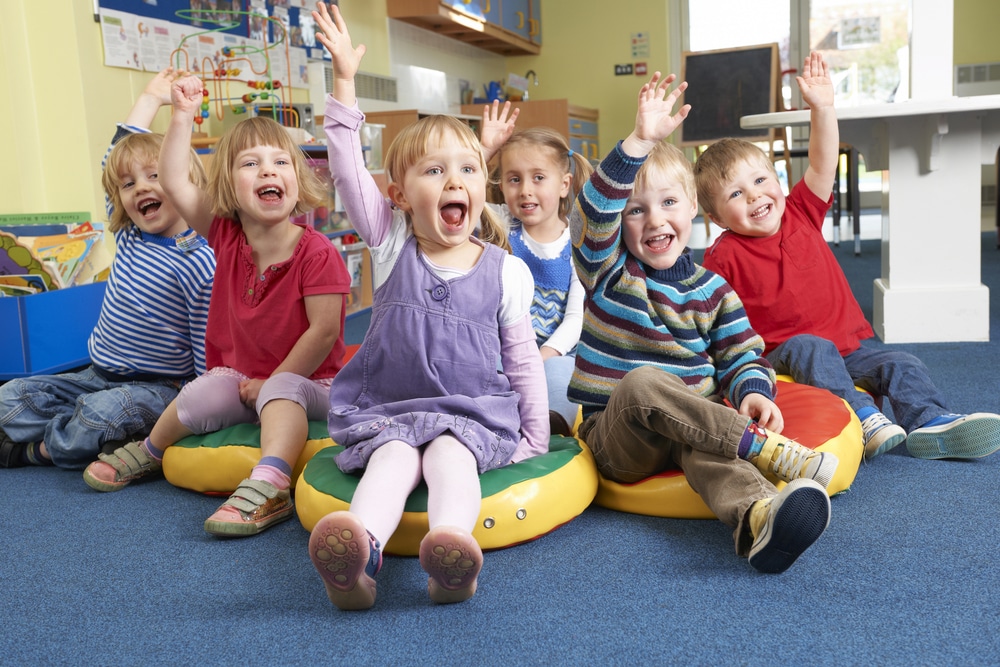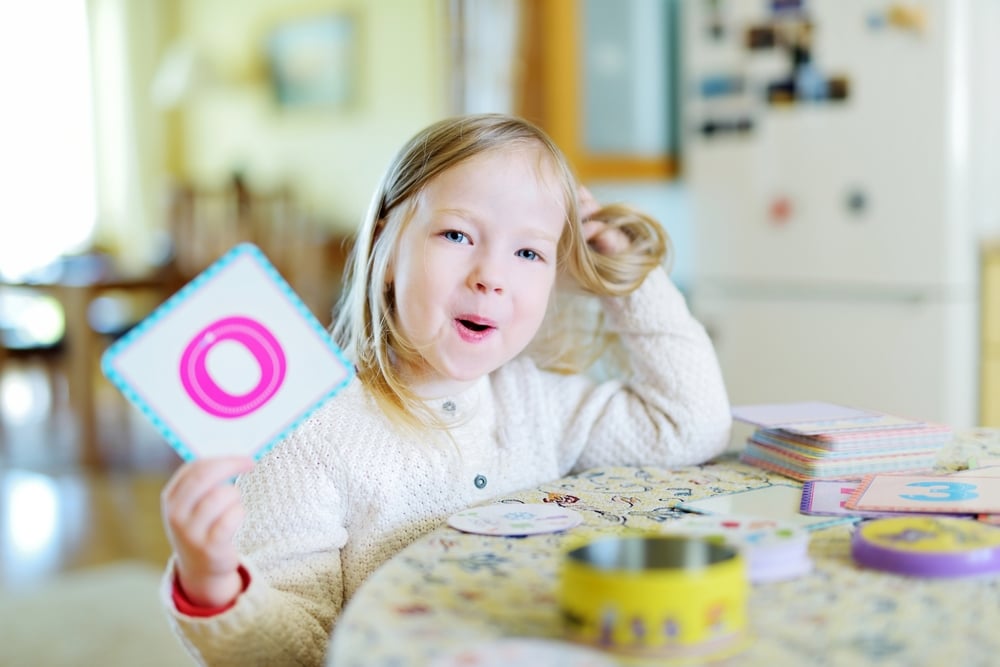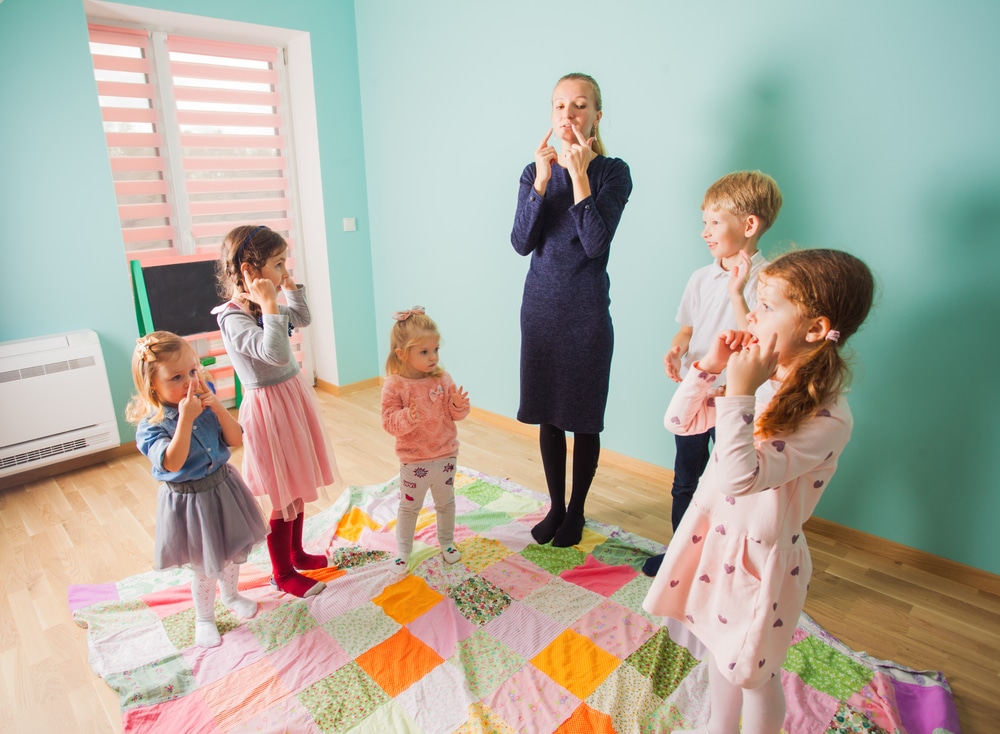
Teaching English for Kindergarten: Tips and Activities for Getting Kids Excited About Learning
It takes a special kind of person to teach kindergarteners.
On my first day teaching at an English academy for kindergartners, I quickly learned that teaching kindergarten requires you to find a special balance between patience and strictness.
Fortunately, since that day I’ve come up with some methods to maintain an orderly classroom while ensuring that students are happy and engaged.
In this post, you’ll find my top tips and activities for a high-energy but productive English kindergarten classroom.
Download: This blog post is available as a convenient and portable PDF that you can take anywhere. Click here to get a copy. (Download)
Contents
- 1. Develop an ESL Routine (and Stick to It)
- 2. Gamify Classroom Management
- 3. Prepare Kid-friendly English Activities
- 4. Incorporate Movement and Dance
- 5. Get Creative with Roleplaying
1. Develop an ESL Routine (and Stick to It)

The best way to control your kindergarten English class isn’t to constantly reprimand them, it’s to create a routine and stick to it. Structure and routines tend to work well with young learners. Many find routines comforting because they always know what to expect.
Here’s part of the routine that I came up with when I taught kindergarten ESL students:
Beginning of class — Teach the vocabulary word/sentence of the day and have students practice it
9:00 to 9:40 — Reading practice
9:40 to 9:50 — Questions and answers about the reading passage
9:50 to 10:00 — Break
10:00 to 10:20 — Conversational English practice
10:20 to 10:50 — Students complete one page in the conversational English workbook, then the class checks answers together
10:50 to 11:00 — Break
11:00 to 11:30 — Students practice the key grammar point of the day, usually something simple like the use of articles or verb tenses
11:40 to 11:50 — Song time (the students learn a new English song every Monday and continue to sing it for the rest of the week)
11:50 to 12:00 — Prepare for lunch (students line up, and in groups of three they wash their hands and grab their eating utensils)
Getting your students on a routine like this isn’t hard, but you do need to be consistent and stick to it, especially when implementing it for the first time. Once your students get used to it, they’ll know what to do and will participate more in class.
2. Gamify Classroom Management
As a kindergarten teacher, you don’t want to be overly strict and make yourself look like the headmaster from “Matilda,” but you also need to have your students listen to you.
The best way to find the balance is to come up with fun little games that grab your students’ attention (while also getting them to participate in English):
Call-and-response
When students are being noisy, English call-and-response prompts are a fun way to grab their attention and get everyone back on the same page. Here are some example prompts:
- “Eyes on me!” Clap your hands and say, “Eyes on me!” Have your students respond by pointing at you and saying “Eyes on you!”
- “Who’s ready?” At any point during class, whenever you ask “Who’s ready?”, your students need to sit upright with their hands on their knees and respond with “I’m ready!”
The more you practice them with the class, the more likely your students will stop talking and pay attention. For a truly gamified experience, you can keep classroom points on the board for every successful call-and-response interaction.
The Token Economy
One of the best ways to motivate kindergarten students to participate and behave is by giving them rewards. Every time your students participate well in class, reward them with a token. At the end of the week or month, let them exchange their tokens for small prizes.
With the token economy, you’ll want to come up with criteria students have to meet before receiving a token so that everyone has the same opportunity. For this reason, I made the following requirements:
- The student has to raise their hand and try to participate in three or more questions.
- The student can only be reprimanded one time for not paying attention in class.
- Students who fight with each other during the lesson are unable to receive a token.
And believe me, kindergarteners are the first to know when you’re not being consistent or fair with your rewards!
3. Prepare Kid-friendly English Activities

A good kindergarten teacher is one who’s energetic and comes prepared with a lot of activities. Below are some ideas for activities that you can add to your lessons.
Nursery Rhymes
Nursery rhymes are great because they’re already geared towards kindergarten-aged kids. They’re also fun because they help the students practice simple English phrases, including routines, animals and days of the week.
If you’re looking for various nursery rhymes to include in your lesson, YouTube is loaded with resources. Two channels that are particularly useful for kindergarten lessons are Fun Kids English and Little Treehouse Nursery Rhymes and Kids Songs.
With the rhymes and other songs on those channels, students can learn about shapes, the alphabet, numbers and a variety of other topics associated with kindergarten-level English.
Check out this post for a list of the best nursery rhymes to use in your ESL classroom.
Telephone
With your students standing in a single-file line, whisper a phrase into the ear of the very last student. That student will then whisper that phrase into the next student’s ear, and they whisper to the next student and so on.
Once the sentence has reached the last person, they’ll say the sentence aloud, then the class will check to see if the sentence stayed correct the entire time.
This is a great activity to practice pronunciation and is especially useful if you have a daily expression that your students learn.
Flashcard Slap
The game is one of my favorites to use with young learners.
To play this game, make flashcards that use the key vocabulary words and expressions you’ve been teaching. You want to go with flashcards that use pictures, as most kindergarten students have difficulty reading—especially if their first language uses a different writing system.
Place three or four flashcards on the board, with all but one being the correct card to choose from. In pairs of two, have students come up to the board with fly swatters (or something similar they can slap with) and say the vocabulary word or expression. The two students then slap the cards on the board and the first student to choose the correct card wins.
If you’re looking for flashcards to download, or you’d just like some inspiration when creating your own, check out ESL-Kids’ flashcard section.
Hot Potato
Hot potato is another energetic activity that works really well with kindergarten students. Simply designate an object like an eraser, ball or anything that’s lightweight and easy to handle as your hot potato.
While you play music, students pass the potato to the next person, and the student holding the potato when the music stops is expected to speak.
The good thing about this activity is that you can modify it to cover a number of kindergarten-related English topics. For example, the student holding the hot potato can…
- Introduce themselves
- Ask another student to introduce themselves
- Make a statement or answer a question related to the material they’ve been learning—examples include students saying their favorite animal, favorite food and time they woke up
- Ask another student a question
Just make sure that the object is hardy and won’t break when dropped, because kindergarteners tend to get really excited!
4. Incorporate Movement and Dance

Kindergartners have a hard time staying still—and they shouldn’t, even during ESL classes! One way to work with this is by incorporating movement into your class. There’s actually a teaching method called Total Physical Response that’s all about enhancing language learning through movement.
Here are some easy ways to try it out:
Verbal Commands
To teach kindergartners about verbs, you can have them respond to the verbs physically. You can even use use verbal commands to teach directions:
- Do a warm-up by introducing simpler verbs like “walk,” “jump” and stand.” Demonstrate each action as you say the word, encouraging your students to mimic your movements.
- Next, say a verb out loud and have your students respond with the respective action. Gradually introduce more complex verbs, like “twirl” and “stomp.”
- Start adding in directions, like “Walk to the window,” or “Run around the chair.” You can make commands longer too: “Stand next to Sam” or “Sit behind the desk.”
- To introduce a dance element, combine several moves: “Jump, twirl, then walk to the door.”
Aside from movement verbs, this activity works too for less traditional verbs like “cook” or “flutter”—you can let your students get creative!
Simon Says
This is a very popular ESL classroom game. Consider adapting it for themed vocabulary:
- Clothes: Simon says touch your shoes.
- Animals: Simon says roar like a lion.
- Colors: Simon says find something yellow.
- Emotions: Simon says make a happy face.
Before starting the game, consider introducing the vocabulary with flashcards or photos as visual aids.
Action Songs
Of course, there’s the classic “Head, Shoulders, Knees” song for teaching kindergartners about body parts.
You can find a lot more action songs on YouTube, such as “The Hokey Pokey” and “If You’re Happy and You Know It.”
There are also songs like “The Wheels on the Bus” where you can add extra motions. On top of following the movements in the song, you can have your students stand or sit next to each other, put their hands on each other’s shoulders and act like a bus.
5. Get Creative with Roleplaying

If you’ve already taught your students vocabulary but still want to deepen their understanding, then roleplaying might be the next step. Kindergartners naturally enjoy roleplaying because they’re imaginative, and they can practice using vocabulary in realistic situations.
These roleplaying activities worked well with my students:
Shopping Trip
Using fake money and props, students can “buy” and “sell” different products. This is great for teaching essential phrases like “How much is this?” or “I want to buy…” It’s also an opportunity to teach kindergartners how to do basic counting with money in English.
Start by dividing the students into two groups: sellers and buyers. The sellers will manage the “shops” and the buyers will be given fake money to purchase items. The buyers approach different shops, talk to the sellers using the phrases learned, and “buy” items of their choice. If there’s time, you can even have the two groups switch.
School Day
This is an extremely familiar scenario for students! Have students take turns roleplaying as a teacher for their classmates, practicing classroom instructions like “Open your books,” “Sit down,” “Let’s start our lesson” or “Class is finished.”
You can even provide classroom props like books, chalk and board erasers to make the roleplaying more realistic.
Family Roleplay
Students take on family roles, such as mother, father and siblings, then talk to each other with simple sentences. For example: “Time for dinner!” or “Let’s go to the park.”
Divide students into small groups, ideally with at least four members each. Each group represents a family. Assign a different family role to each student in the group, then set up specific scenarios, like relaxing together in the evening, eating breakfast, or going out on the weekend.
Whatever roleplaying scenario you choose, make sure that you model how exactly it works first so your students will know what to do!
As you can see, teaching kindergarteners English isn’t hard. You just need to be patient and willing to have fun with your students. If you want to teach a kindergarten lesson like a pro, you just need to be fair and consistent, energetic and plan activities that get them moving and participating in English.
By doing this, you’ll be the teacher that kindergarten students listen to, as well as the fun teacher that they all love.
Download: This blog post is available as a convenient and portable PDF that you can take anywhere. Click here to get a copy. (Download)



